
Anime Impact: Yasuke is the Black Samurai anime that transcends traditional anime storytelling
Having anime you can finish in one sitting is great. Having NEWLY released anime you can watch in one sitting is even better. Yasuke is incomparable to anything I have ever watched, and quite literally the roller coaster of whats, whys, and huhs I needed to get my brain working again.
Yasuke is a six episode Netflix original anime following the life of a Black samurai that left the soldier life after losing the war, and is now tasked with keeping a little girl, Saki, from being captured by missionaries. Having come out in April this year, it’s been one of the most anticipated anime releases of the year, as the main character is based on a real samurai with the same name who lived during the Sengoku period in Japan. Seeing Flying Lotus (famous for his layers of electronic and jazzy beats, and work on Boondocks, Kuso, and Imperial Dreams) and LaKeith Stanfield (known for his performances on Atlanta, Sorry To Bother You, and Get Out) being part of the show, was an easy indicator that the anime was not just going to be a simple period piece, but that a wild, colorful, and somewhat unsettling plot was waiting for viewers.
In Yasuke, the past and present constantly take turns showcasing what the main protagonist, Yasuke, has gone through. You’ll meet Yasuke who was once a servant turned samurai after Lord Nobunaga sees him saving a little boy, to Yasuke becoming Nobunaga’s right hand man during a war, to running away to a seaside town under the new name, Yassan.

Years into his new life, Yasuke faces trouble trying to help a single mother and her sick daughter, Saki, get to a doctor far up in the mountains from their town. Reluctant at first, Yasuke agrees and they start their trek, but is ignorant to the fact that Saki is a child with supernatural powers, and her mother is actually a runaway who worked with a group of bandits that were hired to kidnap Saki, but ultimately chose to save her instead.
There are a few things I loved very much about this anime. Having an anime with a Black lead is special to the Black and Brown community. As a Brown person growing up with anime, skin color in the medium was always a hard trench to go through, with crazy racist depictions, or the societal beauty standard that being dark meant you were ugly or dirty. Although problematic, there were some anime where Black and Brown characters were important, and that BIPOC and POC could see themselves in, such as Michiko from Michiko to Hatchin and Avdol from Jojo’s Bizarre Adventure; but the disconnect there was always that the characters were not being voiced by people who they were trying to portray, even on the side of the English dubbed versions of the shows. In Yasuke however, Black voice actors bring the protagonist to life with the help of Stanfield for the English dub, and Jun Soejima for the Japanese dub.
Another thing that makes this anime stand out is the music from Flying Lotus – a key artist in my daily playlists growing up. From 2014, up until 2016, Flying Lotus’s album, You’re Dead! was an everyday listen that gave me the power to get through my day with it’s layers of mathy beats full of jazz, noise, electronic sounds, and hip-hop. The messy and beautiful pieces he worked on in Yasuke were translated wonderfully through the animation, with fight scenes intensified with the anime’s soundtrack. The music was wild, pretty, surprising, and left me speechless, just like the anime.

But I can say it left me a bit too speechless at times. After its mini missionary arc, with its fight between Yasuke and the band of villains consisting of a Pope, Russian werewolf, a giant robot, a scythe wielding lady, and a spirit summoning man, the series takes a turn in a way I personally felt lost in. While I love a series that has some weird unexplainable happenings like Wonder Egg Priority, Yasuke leaned too much into that. In episode four, Yasuke and Saki continue the search for this mysterious doctor, who turns out to be a teacher that can help shape Saki to be a skilled fighter with her supernatural powers; but the catch here is that now with the band of original villains no longer after her, there is some goddess out to get Saki instead. This seems like a straight-up new enemy to bigger the battle pipeline. It isn’t all bad, the series takes the creative freedom to make the last three episodes look like an interpretive modern art piece, which looks gorgeous outside of the plot, but within, makes the plot of Yasuke feel tangled and confusing.
The ending of the anime did make me feel satisfied as Yasuke himself circles back to the boy he saved many years ago when he was a servant with Nobunaga witnessing the whole ordeal. The boy recognizes him immediately and thanks him, Yasuke gives him a sword, and then disappears. Which after, again, three episodes of confusing but pretty scenes, gave me a sense of relief that I could connect something in the story.
There isn’t any news as of yet if a season 2 will come around, but given how wild I felt watching it, I hope Yasuke comes back bigger and better.
Anime Impact is a column from Monti Velez that looks at anime from a queer and critical perspective.







